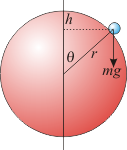From the diagram below we see that the gravitational force normal to the surface of the sphere is given by $f_{n}=mg\cos\theta$.

If the distance from the center of the sphere to $m$ is $r$, the centripetal force needed to hold the ball on the surface of the sphere is $f_{c}=\frac{v^{2}}{r}m$. The vertical distance from the top of the sphere to the $m$ is $h=r-r\cos\theta$, so from conservation of energy we have $hmg=\frac{1}{2}mv^{2}\,\,\Rightarrow\,\,2r(1-\cos\theta)g=v^{2}$. When $f_{n}=f_{c}$ there will no longer be enough force to hold the small mass on the sphere. From this we have
\[ \begin{eqnarray*} mg\cos\theta &=& \frac{v^{2}}{r}m \\ gr\cos\theta &=& v^{2} \\ gr\cos\theta &=& 2r(1-\cos\theta)g \\ \cos\theta &=& 2-2\cos\theta \\ \cos\theta &=& 2/3 \\ \theta & \approx & 48^{\circ}. \end{eqnarray*} \]